Ethereum
Ethereum Flashes Bullish Signals, Can It Rally 50% From Here?

The second-largest crypto token by market cap, Ethereum (ETH), finally showed some form of life as it rose to $3,300 over the weekend. This move is believed to be the beginning of a trend reversal for the crypto token, which has several bullish signals on its chart.
Ethereum Has A Bullish Chart
Crypto analyst Derek revealed in an X (formerly Twitter) post that the signals on Ethereum’s Moving Average Convergence/Divergence (MACD) indicator “seem to have ended the decline and changed upward direction.” He also highlighted the Ethereum Dominance chart, which has confirmed three bottoms and gave a strong rebound.
The analyst explained that “leading a rebound after confirming the bottom three times means that further decline is unnecessary, and there is a high possibility that there is no intention to do so.” Interestingly, the analyst drew attention to the fact that Ethereum has experienced this price rebound without volume.
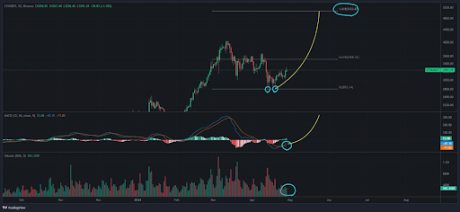
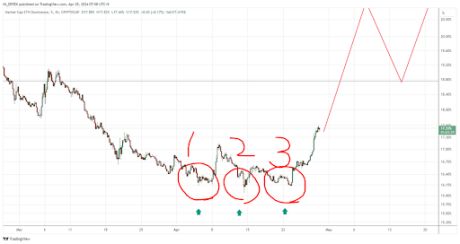
Source: X
This phenomenon occurs when individual investors are more active than institutional ones who are more cautious during this period. This instantly brings recent buys by Ethereum whales like Justin Sun into the picture, as they have contributed significantly to Ethereum’s recent resurgence.
NewsBTC recently reported that a wallet believed to belong to the TRON founder recently bought $405 million worth of Ethereum. This wallet and another suspected to belong to Sun have accumulated $891 million worth of ETH since February 12. Meanwhile, NewsBTC also reported about another whale, who, despite losing $4.5 million worth of longing ETH, opened another long worth over $17 million.
Other Bullish Signals For ETH
Crypto analyst Trader Tardigrade recently revealed that Ethereum experienced a decent breakout to a descending trendline on the daily chart of its Bitcoin pair. He added that Ethereum’s Relative Strength Index (RSI) also shows an associated breakout from a symmetrical triangle.
The crypto analyst claimed that the value of the RSI is also now above 50, which is considered bullish for a crypto token. Based on these signals, Trader Tardigrade stated it is “time for Ethereum.” He also suggested that other altcoins will moon once Ethereum begins its parabolic move to the upside.
Derek also predicted this, stating that the “rise of Ethereum will drive the explosive rise of altcoins that have been oppressed.” While sharing his bullish sentiment towards Ethereum, crypto analyst Crypto Prof echoed a similar sentiment, remarking that altcoins will “run even more” as Ethereum trades significantly higher in the coming months.
Before now, Crypto expert Michaël van de Poppe predicted that the narrative would shift toward Ethereum post-halving and that the crypto token and other altcoins would bounce in their Bitcoin pair once the hype around the halving was over.
At the time of writing, Ethereum is trading at around $3,170, down over 1% in the last 24 hours, according to data from CoinMarketCap.
ETH price sitting above $3,100 | Source: ETHUSD on Tradingview.com
Featured image from AMBCrypto, chart from Tradingview.com
Disclaimer: The article is provided for educational purposes only. It does not represent the opinions of NewsBTC on whether to buy, sell or hold any investments and naturally investing carries risks. You are advised to conduct your own research before making any investment decisions. Use information provided on this website entirely at your own risk.
Ethereum
Ethereum Is ‘Completely Dead’ As An Investment: Hedge Fund


In a post on X this past weekend, Quinn Thompson, Chief Investment Officer (CIO) of Lekker Capital, declared that Ethereum (ETH) is “completely dead” as an investment. His comments sparked a flurry of responses from prominent figures in the crypto industry, including Nic Carter of Castle Island Ventures, Columbia Business School professor Omid Malekan, and VB Capital’s Scott Johnsson.
Thompson, who oversees investments at Lekker Capital, set off the debate with a post stating: “Make no mistake, ETH as an investment is completely dead. A $225 billion market cap network that is seeing declines in transaction activity, user growth and fees/revenues. There is no investment case here. As a network with utility? Yes. As an investment? Absolutely not.”
He also shared a set of metrics to underscore Ethereum’s recent stagnation, including data on active addresses, transaction counts, and new address creation.

Is Ethereum ‘Dead’ As An Investment?
The provocative statement attracted immediate responses from prominent voices across the crypto ecosystem, triggering a debate over Ethereum’s economic and investment thesis, and specifically, the influence of Layer 2 (L2) scaling solutions on Ethereum’s native token economics.
Nic Carter, partner at Castle Island Ventures and co-founder of blockchain analytics firm Coinmetrics, swiftly responded, pinpointing Ethereum’s valuation dilemma squarely at the feet of its Layer 2 scaling implementations:“The #1 cause of this is greedy eth L2s siphoning value from the L1 and the social consensus that excess token creation was A-OK. Eth was buried in an avalanche of its own tokens. Died by its own hand.”
Thompson reinforced Carter’s criticism by suggesting that Ethereum’s community consensus had inadvertently favored token proliferation as a wealth-generation mechanism, ultimately undermining ETH’s investment narrative: “The social consensus among .eth’s in favor of excess tokens was because the creation of endless L2s, staking, restaking, DA, etc etc all enriched their pockets on the way up but no one wants to face the music now that the market is saying that was a mistake.”
However, this viewpoint was contested by Omid Malekan, professor at Columbia Business School and specialist in cryptocurrency and blockchain technology since 2019. Malekan underscored Layer 2s’ critical role in blockchain scalability and argued that any value-extraction by these secondary layers was not inherently detrimental to Ethereum’s foundational token economics: “L2s are the only viable way to scale any blockchain. Whether their tokens capture value or not is a separate question. But it can’t be that L2s ‘siphoned value from ETH’ yet didn’t capture value themselves. Security is not free.”
Malekan further challenged Thompson’s claim by questioning whether Ethereum could realistically become the first example in history of a widely adopted technological network whose utility failed to generate any meaningful financial return: “Is Ethereum going to be the first network ‘with utility’ in modern history where the network effects aren’t monetized? Can you provide any other examples of this happening?”
In response, Thompson clarified his argument, highlighting that monetization is indeed occurring within the Ethereum ecosystem, but not sufficiently accruing to ETH itself to validate the cryptocurrency’s current market capitalization. He illustrated this point with an analogy: “There’s tons of network effects being monetized all over the place, just not enough to ETH to justify its current valuation. Do all the network effects of the oil network and usage of oil accrue to oil?”
However, the oil analogy drew skepticism from Scott Johnsson, General Partner at VB Capital, who critiqued Thompson’s comparison due to Ethereum’s unique tokenomics, particularly its deflationary token burning mechanics influenced directly by network usage:
“I don’t disagree with your directional call, but I think this analogy falls flat. ETH ‘production’ is inversely correlated with usage, which is certainly not the case with oil. So as oil price increases, there is a demand response and a supply response. With ETH, it’s limited to the demand response. If ETH consumption looks like barrel consumption, then the price of ETH is far more likely to accrue value.”
Yet Thompson continued to disagree with Johnsson’s assessment, arguing that historical patterns do not necessarily support the claim of inverse correlation between Ethereum production and usage: “I disagree. We’ve never seen a sustained period of time where ‘ETH production is inversely correlated with usage.’ Obviously, the ‘production’ mechanics differ from oil, but similarly high ETH price is prohibitive to demand, hence L2s and cheaper alternative L1s.”
Acknowledging a possible misunderstanding, Johnsson clarified he was not predicting future Ethereum usage scenarios, emphasizing instead the theoretically inverse relationship between token burn and transaction volume under the current Ethereum network design: “I think we’re talking past each other a bit. I don’t think it’s arguable that if ETH usage increases that it leads to more burn and less inflation (production). I’m specifically not making future predictions on that usage. In any event, your ultimate point is fine imo because the demand side is so sensitive to really any cost.”
At press time, ETH traded at $1,793.

Featured image created with DALL.E, chart from TradingView.com

Editorial Process for bitcoinist is centered on delivering thoroughly researched, accurate, and unbiased content. We uphold strict sourcing standards, and each page undergoes diligent review by our team of top technology experts and seasoned editors. This process ensures the integrity, relevance, and value of our content for our readers.
Ethereum
Whales Accumulate 470,000 Ethereum In One Week – Bullish Momentum Ahead?
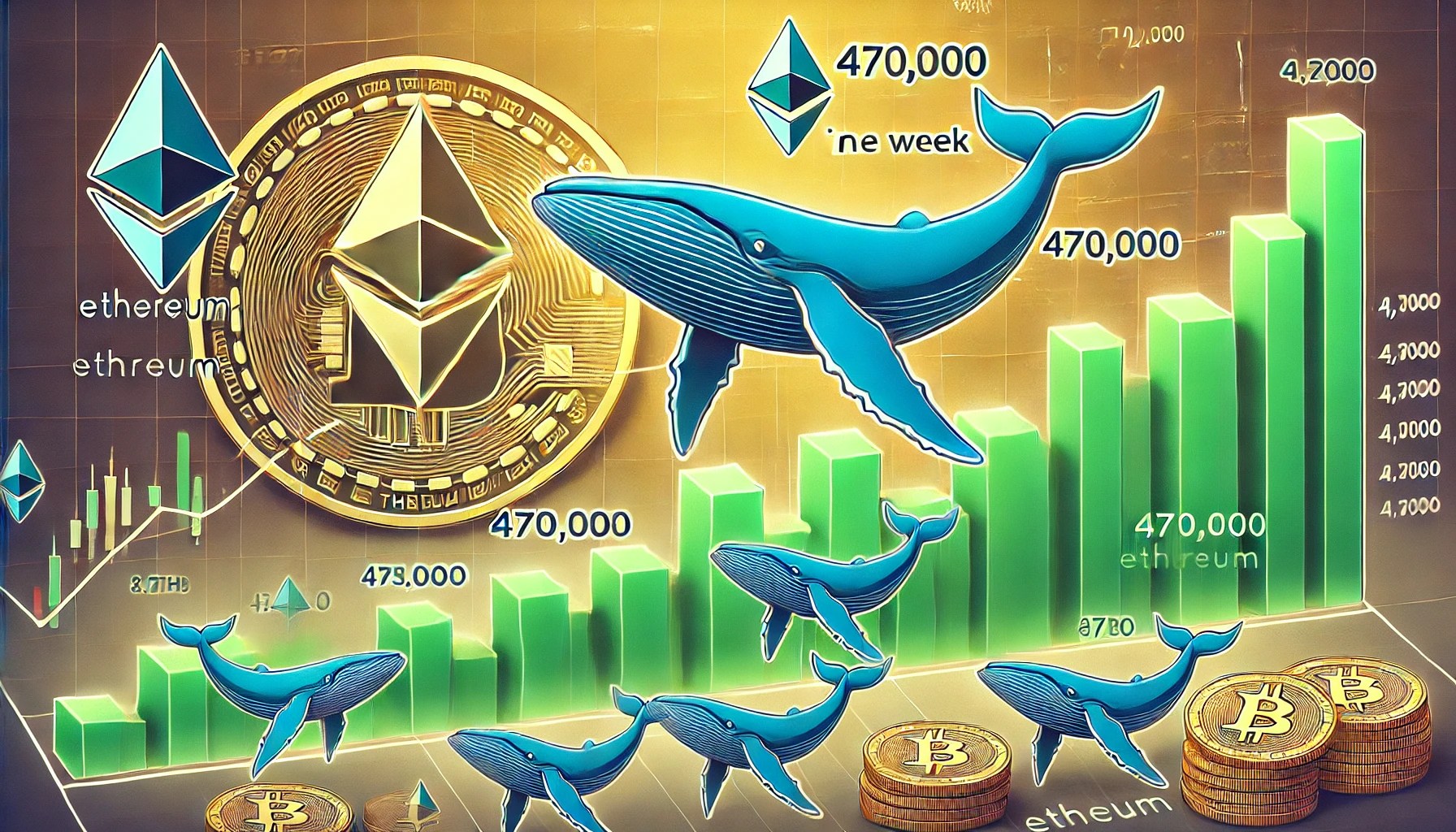

Ethereum is now trading above the $2,000 mark after several days of struggle, marking a potential turning point for the second-largest cryptocurrency by market cap. ETH had plunged over 38% since late February, sparking panic among investors when the price broke below the critical $2,000 level and briefly fell under $1,800. This sharp drop led many to question whether the broader altcoin market was entering a prolonged bear phase.
However, the recent recovery and price stabilization above $2,000 have renewed optimism among Ethereum holders. Many investors believe the worst may be over and that ETH could begin building the foundation for a sustained recovery in the coming months.
Supporting this sentiment, data from Santiment reveals that whales have bought roughly 470,000 ETH over the past week. This notable accumulation from large holders suggests growing confidence in Ethereum’s long-term potential, even amid recent volatility. Historically, whale accumulation has preceded major price rallies, adding to speculation that Ethereum could be gearing up for a significant upward move.
While uncertainty remains, current on-chain signals and market behavior hint that ETH may be preparing for a bullish breakout — if bulls can defend key support levels and reclaim higher ground.
Ethereum Builds Momentum Amid Potential Recovery
Ethereum is showing signs of life after a prolonged period of consolidation and selling pressure. The recent push above the $2,000 mark has given bulls a critical opportunity to reclaim control and ignite a recovery uptrend. However, price action remains uncertain, with the market caught between expectations of a continued downtrend and hopes for a meaningful reversal.
Bulls must now defend the $2,000 support level with strength. This price point has been a major psychological and technical barrier over the past few months, and a solid hold above it could provide the foundation for a broader rally. A failure to maintain this level, however, could invite further downside pressure and signal the continuation of the bearish trend.
Adding to the growing optimism is new on-chain data shared by top analyst Ali Martinez. According to Santiment, Ethereum whales have accumulated roughly 470,000 ETH in the past week. This surge in accumulation from large holders suggests confidence is returning to the market and could indicate that smart money is positioning for a potential move higher.

Historically, heavy whale buying has often preceded major price increases, serving as a leading indicator for broader market sentiment. If bulls continue to step in and Ethereum maintains its footing above $2,000, a recovery toward $2,300 and beyond may soon be on the table.
ETH Price Hovers Above $2,000 As Bulls Try To Find Momentum
Ethereum is trading at $2,090 after a sharp rebound from recent lows, marking its first sustained move above the $2,000 level in weeks. This area has become a critical battleground between bulls and bears, as ETH has struggled below this mark since early March. Now, with price action pushing higher, bulls must defend this support zone to maintain momentum.

To confirm a meaningful recovery, Ethereum must break above the $2,200 resistance—an area aligned with previous consolidation and short-term moving averages. A successful reclaim of this level would likely ignite renewed bullish momentum and open the path toward $2,300 and higher.
However, if bulls fail to hold the $2,000 mark, selling pressure could return quickly. A breakdown below this level would signal weakness and potentially send ETH back toward the $1,800 zone, which served as a recent bottom during the sell-off.
Momentum is slowly shifting, but the next few trading sessions will be crucial. Ethereum needs sustained buying volume and stronger confirmation above $2,200 to establish a true bullish reversal. Until then, the $2,000 line remains the key level to watch as the battle for direction continues.
Featured image from Dall-E, chart from TradingView

Editorial Process for bitcoinist is centered on delivering thoroughly researched, accurate, and unbiased content. We uphold strict sourcing standards, and each page undergoes diligent review by our team of top technology experts and seasoned editors. This process ensures the integrity, relevance, and value of our content for our readers.
Ethereum
Ethereum Analyst Eyes $1,200-$1,300 Level As Potential Acquisition Zone – Details
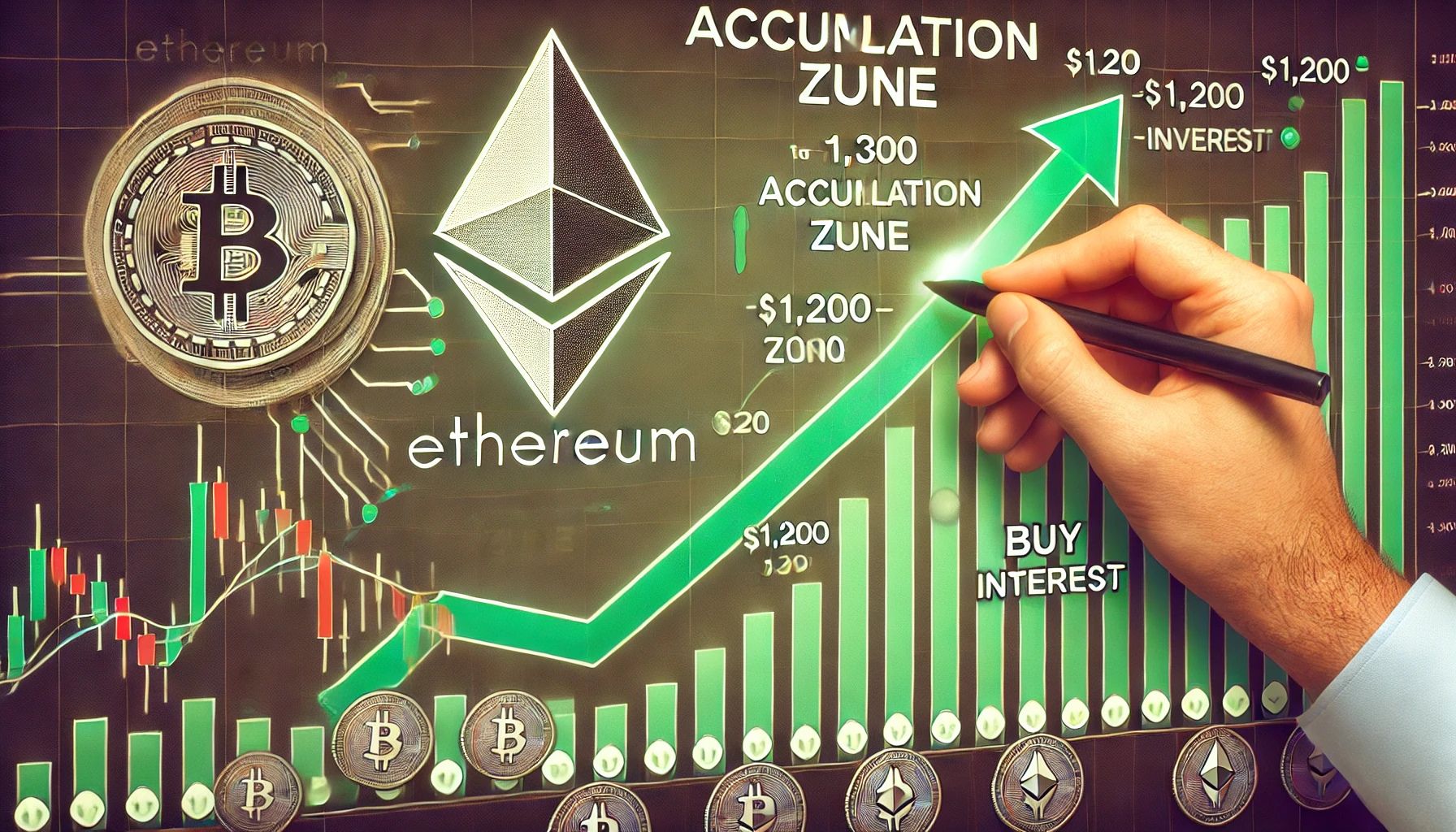
Reason to trust

Strict editorial policy that focuses on accuracy, relevance, and impartiality
Created by industry experts and meticulously reviewed
The highest standards in reporting and publishing
Strict editorial policy that focuses on accuracy, relevance, and impartiality
Morbi pretium leo et nisl aliquam mollis. Quisque arcu lorem, ultricies quis pellentesque nec, ullamcorper eu odio.
Ethereum is facing mounting pressure after weeks of relentless selling and underwhelming price action. Since January, bulls have failed to regain control, and ETH has continued to bleed value in a market increasingly dominated by fear and uncertainty. With no clear signs of a reversal, the coming weeks could bring more pain for investors holding long positions.
Related Reading
Global financial markets remain on edge as trade war fears and geopolitical tensions intensify. This hostile macro environment has driven investors away from high-risk assets like cryptocurrencies, and Ethereum has been one of the hardest hit. The weakness in price reflects not only technical breakdowns but also a broader lack of confidence in short-term recovery.
Top analyst Big Cheds recently shared a technical analysis showing Ethereum is now trading at $1,840 — a staggering drop from its $3,400 level earlier this year. According to Cheds, this confirms the continuation of the current downtrend, with ETH now moving into lower demand zones that could offer limited support.
Unless bulls step in with strength, Ethereum’s outlook remains bearish. The market is watching closely to see if $1,800 can hold — or if deeper losses lie ahead as momentum continues to favor the downside.
Ethereum Under Pressure As Key Levels Collapse
Ethereum is in a critical position as it continues to lose key support levels under mounting selling pressure. After briefly reclaiming the $2,000 mark in recent weeks, ETH has once again fallen below this crucial threshold — a failure that has intensified bearish sentiment and placed bulls in a defensive stance. With each failed recovery attempt, investor confidence weakens, and analysts are now calling for a deeper correction in the coming weeks.
The situation is particularly delicate as Ethereum serves as the backbone for much of the crypto ecosystem. A sustained downtrend in ETH doesn’t just impact its own holders but also influences the broader altcoin market and DeFi sectors that rely on Ethereum’s price strength for momentum. The continued decline has heightened concerns that a prolonged bear phase may be unfolding.
Big Cheds shared a bearish technical outlook, pointing to the severity of ETH’s drop from its $3,400 local high to the current $1,840 level. According to Cheds, if the downtrend continues, the next key accumulation zone to watch could be between $1,200 and $1,300 — a range that previously acted as a strong base during earlier cycles.

If Ethereum falls to that zone, it would represent a correction of over 60% from its recent peak. Such a move would signal a major breakdown in structure and test long-term investor conviction. For now, bulls must fight to hold the $1,800 level and attempt to reclaim lost ground. Without a shift in momentum soon, the road ahead for ETH looks increasingly challenging — and the broader market may follow its lead downward.
Related Reading
Key Resistance Levels Remain Untouched
Ethereum is currently trading at $1,840, continuing to show weakness after failing to reclaim the 4-hour 200 moving average (MA) and exponential moving average (EMA), both sitting near the $2,100 level. These indicators have acted as strong dynamic resistance since December 2024, and ETH has consistently traded below them — a clear sign that bears remain in control of the trend.
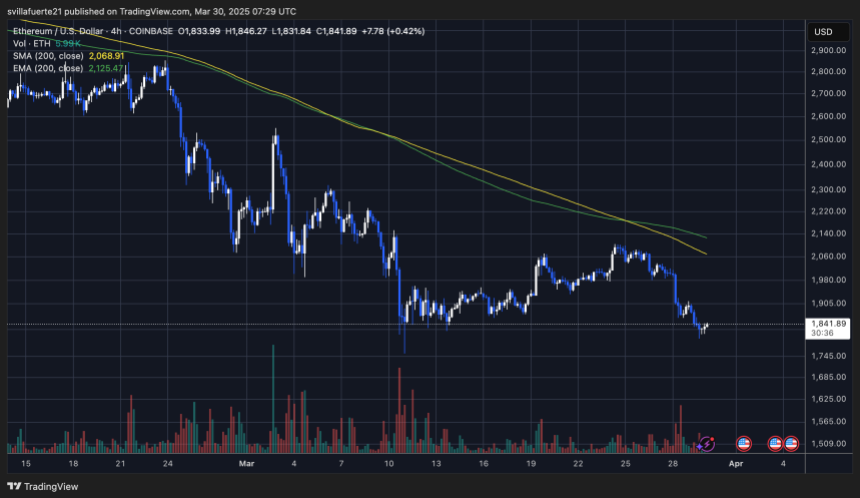
This prolonged weakness below the 200 MA and EMA has reinforced the bearish momentum, with bulls unable to regain any meaningful ground in recent months. Until Ethereum can break back above these key technical levels, any attempt at a sustained recovery is likely to fall short.
A reclaim of the 200 MA and EMA could trigger a significant upside move, as it would signal a shift in short-term market structure and potentially spark renewed buying interest. However, even before that happens, bulls must focus on reclaiming the psychological $2,000 level — a major price zone that has repeatedly defined the battle between buyers and sellers.
Related Reading
If ETH can break above both $2,000 and $2,100 with volume, it may mark the beginning of a stronger recovery phase. Until then, price action remains vulnerable and tilted toward the downside.
Featured image from Dall-E, chart from TradingView
-

 Ethereum22 hours ago
Ethereum22 hours agoEthereum Analyst Eyes $1,200-$1,300 Level As Potential Acquisition Zone – Details
-

 Ethereum21 hours ago
Ethereum21 hours agoWhales Accumulate 470,000 Ethereum In One Week – Bullish Momentum Ahead?
-

 Ethereum23 hours ago
Ethereum23 hours agoEthereum May Have Hit Cycle Bottom, But Pricing Bands Signal Strong Resistance At $2,300
-

 Bitcoin22 hours ago
Bitcoin22 hours agoGold Keeps Outperforming Bitcoin Amid Trump’s Trade War Chaos
-

 Market20 hours ago
Market20 hours ago3 Token Unlocks for April: Parcl, deBridge, Scroll
-

 Regulation18 hours ago
Regulation18 hours agoJapan Set To Classify Cryptocurrencies As Financial Products, Here’s All
-

 Market17 hours ago
Market17 hours agoTop 3 Made in USA Coins to Watch This Week
-

 Ethereum24 hours ago
Ethereum24 hours agoEthereum MVRV Ratio Nears 160-Day MA Crossover – Accumulation Trend Ahead?















